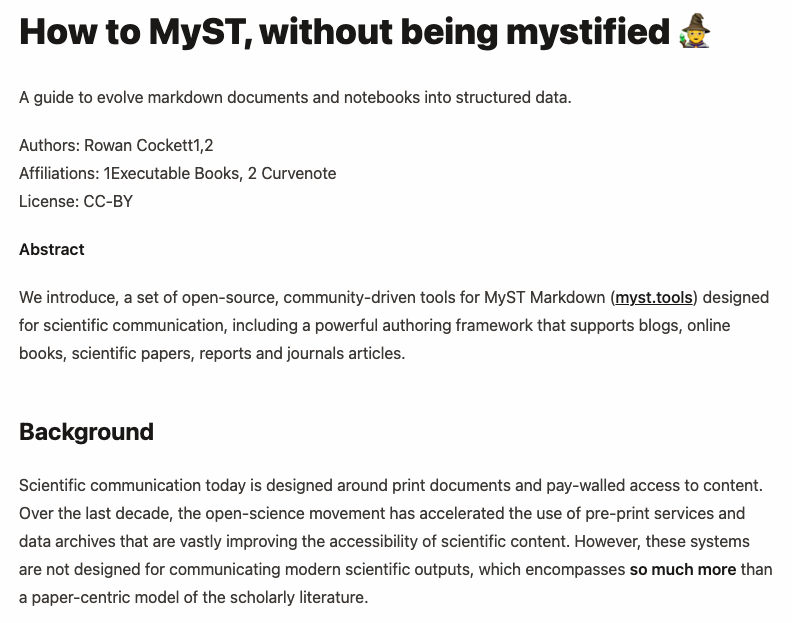Frontmatter
(2025-08-17T04:56.593Z)
Perplexity Query
(2025-08-17T04:56
.593Z)
Question:
Write a comprehensive one-page article about "Frontmatter in Markdown".
Response from sonar-pro:
Frontmatter in Markdown is a block of metadata placed at the very beginning of a Markdown file, typically written in YAML format and enclosed by triple dashes (---). This small section serves as a way to attach important information such as titles, authors, dates, tags, or custom settings to content, enabling content management systems and static site generators to programmatically interpret and organize files.
[i9l20a]
[dlp3xx]
The significance of frontmatter lies in its ability to separate configuration from content, making Markdown not just human-readable text but also machine-readable data for web publishing, documentation, and content organization.
[jxe1pq]
[dlp3xx]

Frontmatter works by introducing a simple YAML or other data-format block at the top of a Markdown document. For example:
markdown
---
title: "Introduction to Markdown Frontmatter"
date: 2025-08-17
author: "Alex Chen"
tags: [markdown, metadata, content]
draft: false
---In this example, the section between the triple dashes contains key-value pairs offering metadata about the file. This information can be extracted and used by static site generators like Jekyll, Hugo, or Next.js to automate tasks such as displaying titles, generating publication dates, organizing posts by category, or setting SEO properties.
[0k0b17]
[i9l20a]
[dlp3xx]
Tools like Prezet and Zudoku also leverage frontmatter to configure publish status (e.g., marking drafts), customize navigation, and handle page-specific properties, such as table of contents settings or sidebar icons.
[0k0b17]
[i9l20a]
The main benefits of frontmatter are its flexibility and universality across many platforms. It streamlines website management by letting authors define metadata within the document itself, reducing administrative overhead. Frontmatter is essential for SEO optimization; systems can use metadata fields like description, tags, or image to generate rich search previews or Open Graph tags for social sharing.
[0k0b17]
[dlp3xx]
[ynr2ro]
Moreover, it facilitates workflows in larger teams by standardizing how project or documentation metadata is stored and interpreted. Its applications extend beyond blogs and websites; frontmatter is used in personal knowledge bases (e.g., Dendron), technical documentation, and even in publishing e-books.
[jxe1pq]
However, frontmatter introduces challenges. New users may overlook its syntax or utility, especially since incorrectly formatted YAML can cause content misinterpretation or build errors. Schema consistency is another concern: as frontmatter is untyped by default, maintaining uniform metadata across large projects can be difficult without validation or tools that enforce conventions.
[0k0b17]
Additionally, not all Markdown parsers support frontmatter, so compatibility issues may arise with simpler or legacy tools.
Current adoption is widespread, especially in static site generators, headless CMS platforms, and developer documentation systems. GitHub Docs uses YAML frontmatter for content versioning and page layout control, as do tools like Jekyll, Hugo, and Bridgetown, each enabling users to define and query metadata.
[jxe1pq]
[dlp3xx]
Recent technological developments have seen projects like Prezet introduce typed frontmatter, offering schema validation and stronger guarantees about metadata structure, improving reliability for teams managing hundreds or thousands of files.
[0k0b17]
CMS services and documentation engines now increasingly surface frontmatter as a core feature for content modeling and workflow automation.

Looking ahead, the importance of frontmatter is expected to grow as digital publishing, documentation, and knowledge management further automate and modularize. Schema validation and editor support are likely to become more sophisticated, lowering the barrier for non-technical users and enhancing data consistency.
[0k0b17]
Integration with visual editing environments, richer schema definitions (e.g., JSON Schema for YAML), and interoperability across platforms are ongoing trends. The rise of AI-powered tooling may also leverage frontmatter metadata to personalize content delivery or automate curation.
In summary, frontmatter in Markdown elevates plain text content to structured, metadata-rich documents that power modern, automated publishing workflows. As digital content ecosystems become more complex and dynamic, robust metadata practices like frontmatter will remain foundational for flexibility, discoverability, and organization in content management.
Citations
[0k0b17] 2025, May 28. Typed Front Matter - Prezet. Published: 2024-05-06 | Updated: 2025-05-28
[i9l20a] 2025, Jul 11. Frontmatter - Zuplo Docs. Published: 2025-07-11 | Updated: 2025-07-11
[jxe1pq] 2025, Jun 13. markdown-cheatsheet/frontmatter.md at master - GitHub. Published: 2021-12-26 | Updated: 2025-06-13
[dlp3xx] 2025, Aug 09. Using YAML frontmatter - GitHub Docs. Published: 2025-01-01 | Updated: 2025-08-09
[ynr2ro] 2025, Aug 15. What exactly is Frontmatter? - Daily Dev Tips. Published: 2024-03-03 | Updated: 2025-08-15